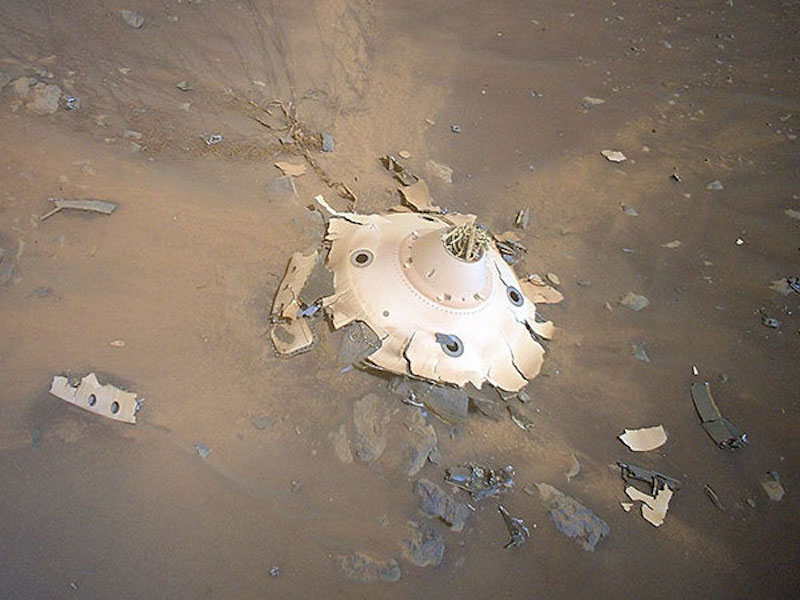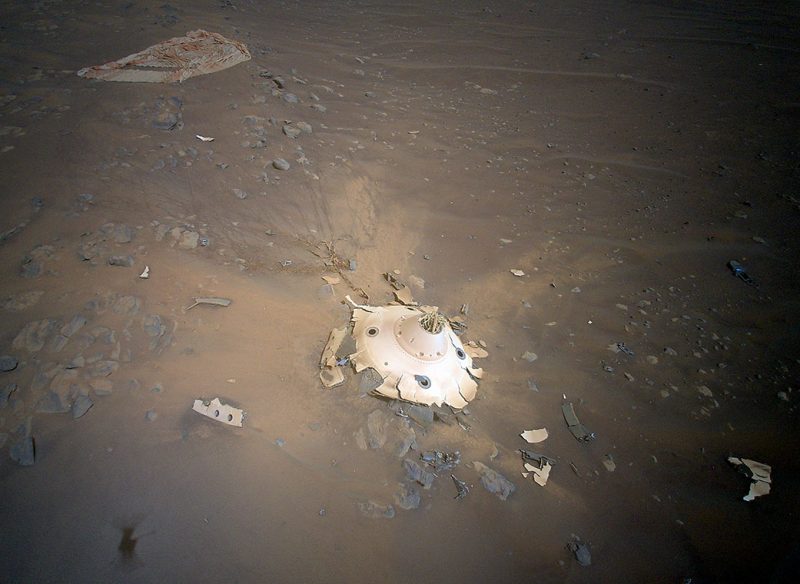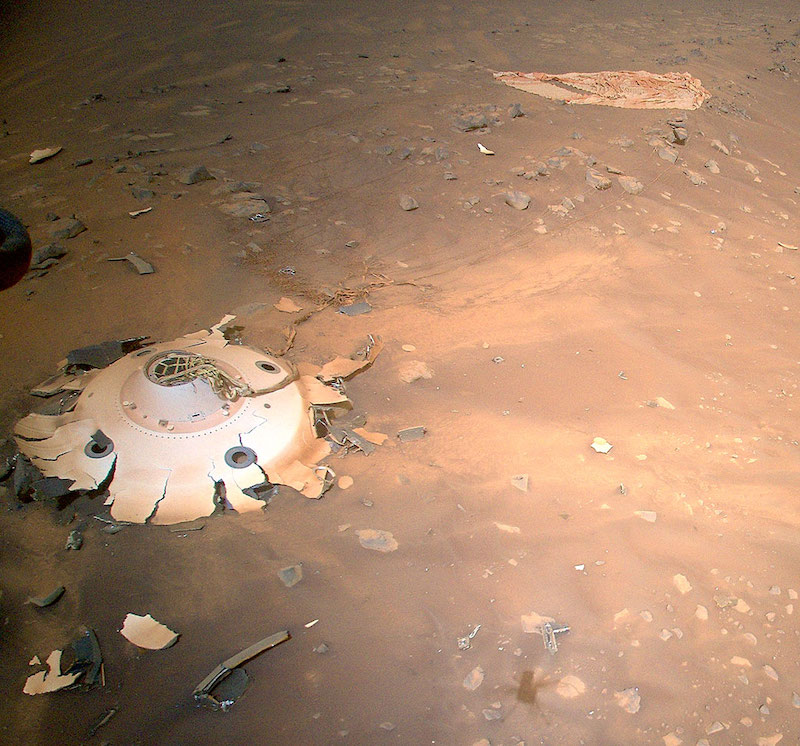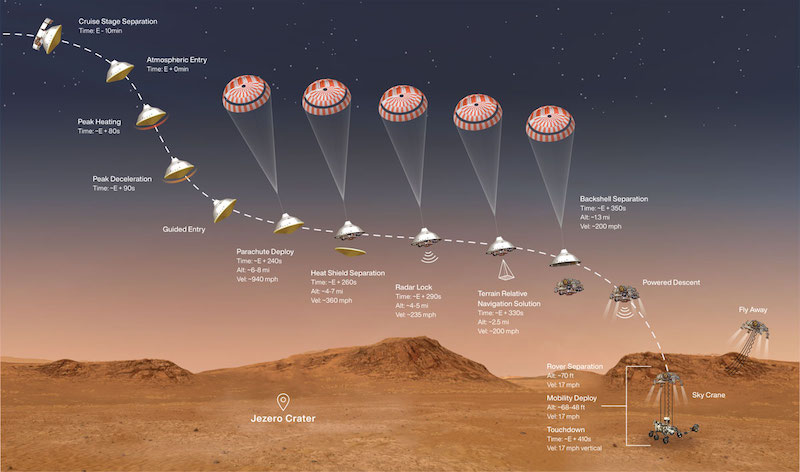
When the Perseverance rover landed in Jezero Crater on Mars on February 18, 2021, it was a spectacular success. During the descent to the surface, the rover’s supersonic parachute and protective backshell were essential for a safe touchdown. As planned, they landed – or rather crashed – some distance away from the rover’s landing spot. On April 27, 2022, NASA announced that Perseverance’s little companion, the Mars helicopter Ingenuity took the first aerial images of the parachute and backshell, still lying where they crashed over a year ago. The high-resolution photos are stunning in their detail and provide valuable insights into the landing procedure.
Mars helicopter surveys wreckage of landing gear
Cameras on the descent stage captured rover’s landing gear debris in incredible detail. Now, the Ingenuity helicopter has obtained high-resolution photos of the wreckage of the backshell and parachute, still lying where they crashed over a year ago. Other Mars rovers have seen debris before, but this is the first time that such landing gear wreckage has been observed from the air. That in itself is an amazing feat … a working helicopter on Mars!
Ingenuity took the new images during its 26th flight, on April 19, from a height of 26 feet (eight meters). For the first image, Ingenuity flew 630 feet (192 meters) to the southeast. Then, it flew southwest and later northwest, capturing additional images. After taking ten images, the helicopter headed west for 246 feet (75 meters) before finally landing. Ingenuity flew 1,181 feet (360 meters) altogether.
Håvard Grip, chief pilot of Ingenuity at NASA’s Jet Propulsion Laboratory (JPL), said:
To get the shots we needed, Ingenuity did a lot of maneuvering, but we were confident because there was complicated maneuvering on flights 10, 12 and 13. Our landing spot set us up nicely to image an area of interest for the Perseverance science team on Flight 27, near Séítah ridge.
Overall, Ingenuity has logged more than 49 minutes flight time and traveled 3.9 miles (6.2 km). Not bad for the first-ever helicopter on Mars!



Landing on Mars is hard
Landing on Mars has always been difficult, due to the very thin Martian atmosphere. This was especially true for Perseverance, the largest and heaviest rover to touch down on the dusty, sandy surface so far. But even in the rarified atmosphere, the rover experiences extreme heat when it enters at nearly 12,500 miles per hour (20,000 kph).
The parachute and backshell are two of the most important pieces of equipment used during the landing. The huge parachute, of course, helps to slow down the rover enough to be able to land safely, before the rover is finally lowered to the surface on cables from the descent stage. The descent stage separates from the parachute and, after the cables to the rover have been cut, flies off to crash elsewhere.
The backshell, part of the aeroshell, helps to protect the rover and descent stage as they travel through space and then plunge into the atmosphere. The backshell, along with the parachute, also crash-lands away from the landing site.


Best documented Mars landing in history
The landing, while hard, was also the best documented Mars landing in history. As Ian Clark at JPL stated:
Perseverance had the best-documented Mars landing in history, with cameras showing everything from parachute inflation to touchdown. But Ingenuity’s images offer a different vantage point. If they either reinforce that our systems worked as we think they worked or provide even one dataset of engineering information we can use for Mars Sample Return planning, it will be amazing. And if not, the pictures are still phenomenal and inspiring.
Clark was also the man behind the Dare Mighty Things secret message encoded into the rover’s parachute.
You can watch the landing as it happened in the video below:
Perseverance’s landing was an incredible success. And now, scientists and engineers will be able to study the landing gear debris in the images, which will help them to design even better landing systems for future rovers. This is especially important for being able to land in areas that are the most scientifically interesting. By nature, those regions tend to be rocky, with hills, valleys, craters and sand dunes. This also makes them the most difficult to land safely in. But Perseverance – and Ingenuity – has shown, in spades, that it can be done.
Perseverance itself has just arrived at the ancient river delta in Jezero Crater, where it will continue to search for evidence of ancient Martian life.
Bottom line: NASA’s Mars helicopter, Ingenuity, has sent back some incredible new photos of the backshell and parachute that helped the Perseverance rover land over a year ago. The battered landing gear still lies on the ground in the same places where it crashed, as planned.
The post Mars helicopter spots rover’s landing gear debris first appeared on EarthSky.
0 Commentaires